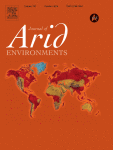Ver ítem
- xmlui.general.dspace_homeCentros Regionales y EEAsCentro Regional La Pampa - San LuisEEA San LuisArtículos científicosxmlui.ArtifactBrowser.ItemViewer.trail
- Inicio
- Centros Regionales y EEAs
- Centro Regional La Pampa - San Luis
- EEA San Luis
- Artículos científicos
- Ver ítem
Vegetation composition and structure changes following roller-chopping deforestation in central Argentina woodlands
Resumen
Driven by the pressure of increasing forage production, dry forests and woodlands of Argentina are suffering one of the highest deforestation rates in the world. In this study we combined field work and a remote sensing approach to assess the successional trajectory in terms of functional group diversity and ecosystem phenology, following roller chopping deforestation in a woodland of central Argentina. The first year after disturbance, shrub cover
[ver mas...]
Driven by the pressure of increasing forage production, dry forests and woodlands of Argentina are suffering one of the highest deforestation rates in the world. In this study we combined field work and a remote sensing approach to assess the successional trajectory in terms of functional group diversity and ecosystem phenology, following roller chopping deforestation in a woodland of central Argentina. The first year after disturbance, shrub cover decreased at the same proportion than grass cover increased while tree cover was drastically reduced. After 3 years, shrubs recovered 70% of the original cover and grasses maintained a relatively high proportion, but tree cover remained low. Roller-chopping favoured early over late successional species in the case of woody plants, but had the inverse effect in the case of grasses. At ecosystem scale the length of the growing season was drastically shortened by 100 days following disturbance. Roller chopping improves ecosystem services of provision by enhancing forage’s offer but at the same time deteriorated the system by reducing functional plant diversity and by shortening the growing season, with potential cascade-consequences on other ecosystem processes such as the carbon and water dynamics.
[Cerrar]

Autor
Steinaker, Diego F.;
Jobbagy Gampel, Esteban Gabriel;
Martini, Juan Pablo;
Arroyo, Daniel Nicolas;
Pacheco, Jorge L.;
Marchesini, Victoria A.;
Fuente
Journal of arid environments 133 : 19-24. (October 2016)
Fecha
2016-10
ISSN
0140-1963
Formato
pdf
Tipo de documento
artículo
Palabras Claves
Derechos de acceso
Restringido
 Excepto donde se diga explicitamente, este item se publica bajo la siguiente descripción: Creative Commons Attribution-NonCommercial-ShareAlike 2.5 Unported (CC BY-NC-SA 2.5)
Excepto donde se diga explicitamente, este item se publica bajo la siguiente descripción: Creative Commons Attribution-NonCommercial-ShareAlike 2.5 Unported (CC BY-NC-SA 2.5)

